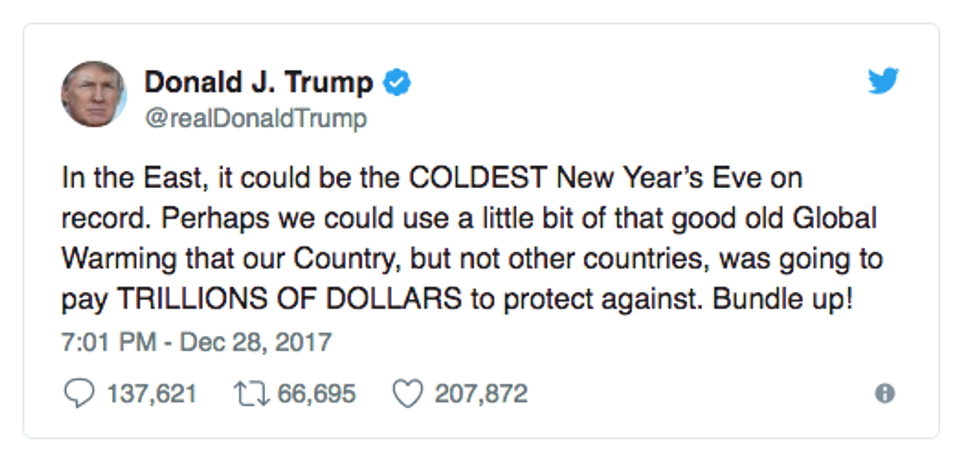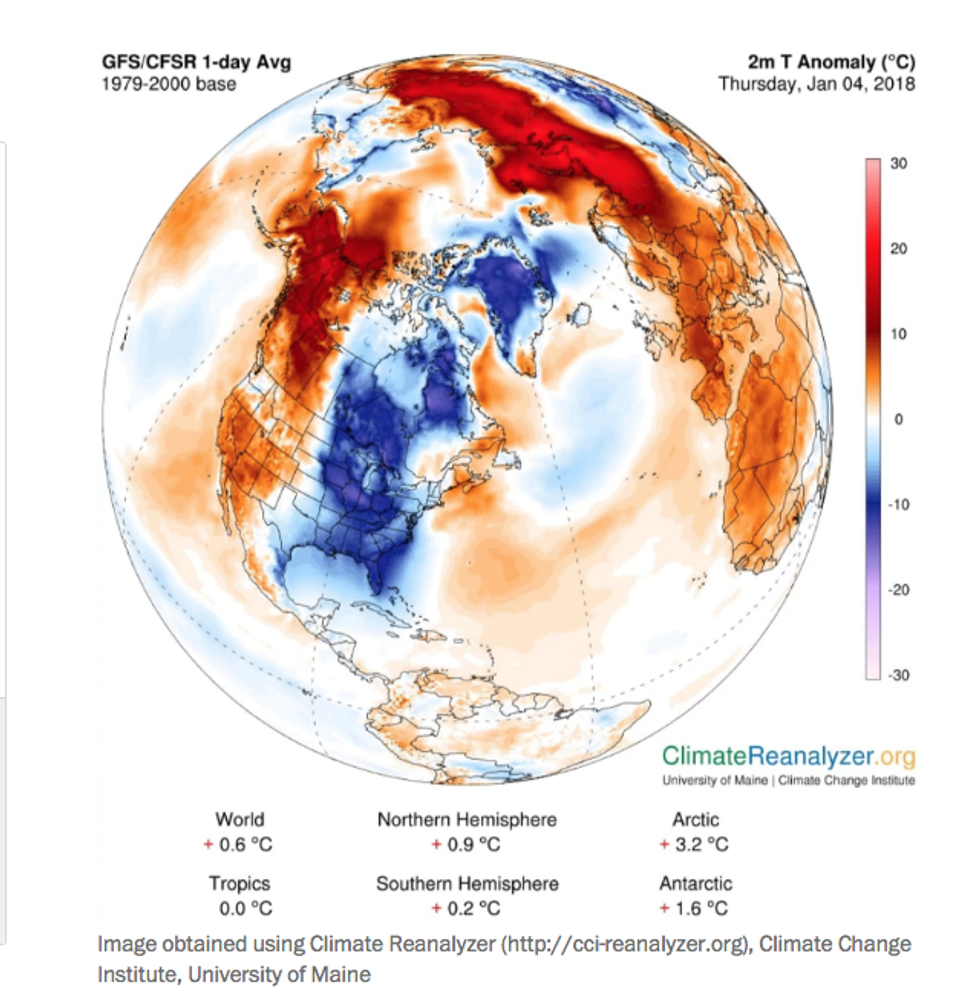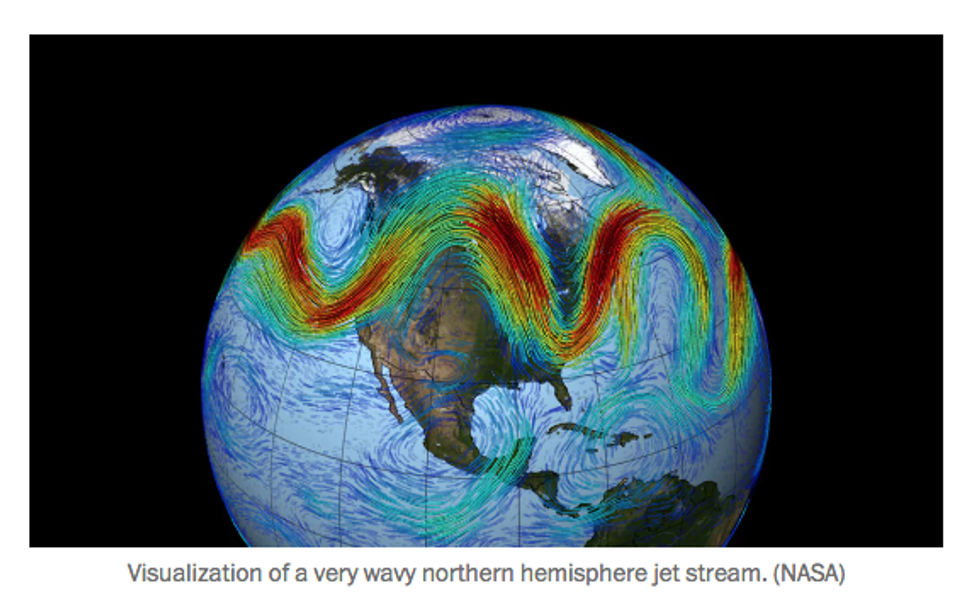Last week, President Trump forced us to address the easy question about climate change and winter cold. No — experts loudly responded to a Trump tweet — unusual cold in one region of the globe during winter does not mean the globe as a whole is not warming.
The far harder question is how climate change will alter the experience of winter itself. It will — it already has.
While the world is certainly experiencing an overall warming trend, much more goes into winter than temperature alone — snowfall depends on moisture in the atmosphere, and under climate change, that is increasing. And snowy weather patterns depend on the large-scale flow of the atmosphere, which is changing, too.Many of the questions about climate change and winter extremes lack satisfying answers at the moment, but there are some key points to highlight:
Cold spells don't refute global warming.
First and most obviously, scientists stress that nothing about winter cold — even the extremes now assaulting the East Coast in a historic "bomb cyclone" — refutes global warming. They've been making the point even more loudly in the wake of this tweet:
Noah Diffenbaugh, a Stanford climate scientist, used a sports analogy to explain "why we should fully expect there to be cold periods, even though we are experiencing overall global warming."
"Steph Curry is, every year, near the top of the NBA free-throw percentages, he makes on the order of 90 percent of his free throws year in and year out," said Diffenbaugh. "If you turn on the TV and see him miss a free throw, or see him miss two free throws, that doesn't lead to the conclusion that he's no longer a good free-throw shooter."
For the U.S., scientists are focused on a curious winter "dipole" that warms the West and freezes the East.
At the same time, research by Diffenbaugh and his colleagues have suggested that at least one odd winter weather pattern affecting the United States of late is getting more common in a way that might be related to a changing climate.
It's called the "North American winter temperature dipole" — and what it basically means is a winter situation in which the U.S. West through the Rockies is abnormally warm, while the U.S. East is abnormally cold. This situation tends to arise when a ridge of high pressure sets up over the western U.S., even as a low pressure trough sets up over the east.
This means, Diffenbaugh said, that storm tracks go around the ridge to its north but then plunge southward over the eastern United States, carrying cold air from the Arctic with them.
"They're underneath a poleward directed flow in the West Coast, and we're under a region of equatorward directed flow in the east, so we're being flooded with Arctic air," added Jonathan Martin, a professor of atmospheric sciences at the University of Wisconsin. "So we're freezing."
Diffenbaugh's research suggests the dipole is becoming more common in concert with greenhouse gas emissions — but also that the west-to-east contrast should become less sharp as global warming mutes winter temperatures overall.
"When we look back, we find that these warm west, cold east periods in the winter have been increasing in their frequency," Diffenbaugh said. "So it's not just people's intuition."
Questions about the jet stream are far from resolved.
But what's driving these types of situations?
There are a lot of ideas, one of which involves changes to the high-altitude jet stream, which plays a powerful role in driving northern hemisphere weather, and which Rutgers University scientist Jennifer Francis suggests has been getting more wavy and elongated of late, intensifying both ridges and troughs and leading extreme weather to get stuck in place for longer.
Francis and her colleagues believe this is tied to the rapid warming of the Arctic, which is lessening the temperature differential between the equator and the North Pole. The Arctic is currently very warm — anomalously so, with especially warm areas over Siberia and Alaska.
Here's what a wavy jet stream looks like:
Francis said by email that the current situation represents "a great example of this connection between natural variability and climate change," positing a partial Arctic role in the current dipole. She said she thinks sea ice loss in the Pacific part of the Arctic helps a ridge form over the U.S. West Coast, and matters proceed from there.
"The Arctic factor makes this pattern more amplified and therefore more persistent," Francis said.
Others remain unsure, though.
"It's just inconclusive at this stage," said the University of Wisconsin's Martin. "I think the jet is getting wavier, I'm not sure it's connected to the Arctic," he added.
"It's fair to say that at the moment, there are multiple hypotheses that are viable and are being tested," said Diffenbaugh.
"Bomb cyclones" could intensify going forward.
Then there is the current weather system, an extreme nor'easter or (the currently favored term) "bomb cyclone" that features an explosive pressure drop and is being partly driven by the temperature contrast between the very cold U.S. East Coast and the warm Atlantic Ocean waters offshore.
"The storm will also feed off of above-normal [sea surface temperatures] along the East Coast, which fuel its intensity and precipitation amounts," said Francis. "Those warm [sea surface temperatures] are at least in part caused by global warming."
Recent research on winter storms, or cyclones, affecting the U.S. East Coast does suggest the possibility of future intensification due to climate change. A 2014 study by Christopher Marciano and two colleagues from North Carolina State University found that these storms would develop lower pressures and feature stronger winds and more precipitation in a future of higher greenhouse gas emissions and a warmer and more moist environment.
"If I was going to extrapolate to the future, I would say these types of systems, where all the ingredients come together, in the future the environment would be primed for them to be stronger," said Marciano, who is now a technical meteorologist with Weather Analytics.
But here Martin suggests caution, especially when it comes to the role of climate change and how it has affected the ocean temperatures fueling the storm.
"It's probably been slightly enhanced in the slightly warmer climate we're in now, but fractionally," he said. "The thing that's unusual is the presence of our cold air outbreak has made the adjacent continent really cold, so the contrast is really enhanced, compared to what might normally be the case on January 3."
To summarize, then, there is a lot of debate and also a lot that is unknown about how winter will change as the climate changes — but it will. Meanwhile, scientists will continue to chew over some of the more contentious ideas, like the one about the changing jet stream.
"It's plausible, it's worthy of debate, it's worth us arguing among ourselves," said Martin. "That's the whole way this whole scientific method works, which makes it fun. … I think there's a lot of good thinking going on, and we're going to keep on learning."
Chris Mooney wrote this in The Washington Post on January 4, 2018.
###
January 5, 2018
Post Script. Thanks, Chris Mooney. At least, those of us suffering from unusual and extreme cold now better understand why. Did I mention Trump is a moron!




